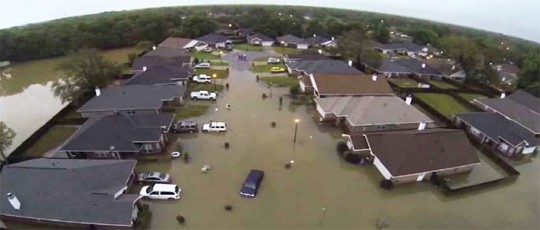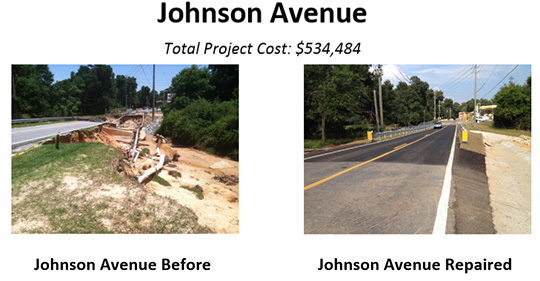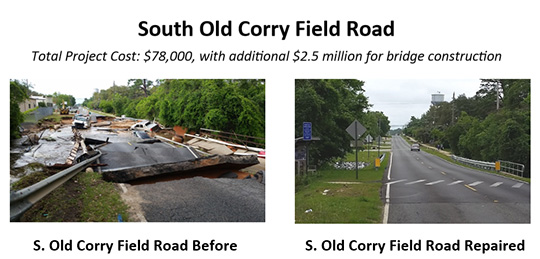Recovery Report: Escambia County One Year After The Flood
April 30, 2015
by Escambia County Administrator Jack Brown
One year ago, a slow-moving weather front flooded Escambia County with more than 20 inches of rain in less than one day. When the rain ceased, recovery began and is still in progress today.
County estimates of damage to government infrastructure and buildings topped a staggering $90 million with transportation, utilities, parks and public facilities all significantly impacted.
Although the road to recovery seemed daunting, County staff and residents banded together to rebuild. In the days immediately following the flood, Public Works crews removed more than 280 tons of debris and pumped one million gallons of water out of neighborhoods that were too waterlogged to drain. Major flood-damaged roads were quickly reopened and hard-hit communities such as Crescent Lake and the neighborhoods off of Old Corry Field Road are in visibly better shape today than they were just six months ago.
Despite the progress, the long-term effects of the disaster on Escambia County are still being felt in our community. While some residents continue to recover from the devastation to their homes and the loss of cherished belongings, others face the unimaginable struggle of coping with the loss of life suffered during April’s tragic events.
We are focused on rebuilding Escambia County stronger and better. But this is not a sprint – it’s a marathon. Destruction from the April flood resulted in 2,318 identified infrastructure damage sites. All of those identified sites have been addressed in some way; either through a temporary or permanent fix, or are currently under some form of construction. However, many large-scale public construction projects involve a much longer timeframe for repair.
Escambia County was able to move quickly to return our streets, parks and facilities to near-normal conditions on our own, without having to wait for federal assistance thanks to the confidence residents placed in us with the passage of the Local Option Sales Tax (LOST). That support, coupled with responsible financial management of taxpayer money exercised by the Board of County Commissioners, allowed the Board to authorize a $10 million interest-free loan from the LOST III Fund to the Disaster Recovery Fund to kick-start recovery efforts.
The County is leveraging those funds by working with an alphabet soup of federal agencies to help pay the cost of repairs. These agencies include: the Federal Emergency Management Agency Public Assistance (FEMA-PA), the Federal Highway Administration Emergency Relief Program (FHWA-ER) and the US Department of Agriculture’s Natural Resources Conservation Service (NRCS) Emergency Watershed Protection (EWP) program. With any of these agencies, the County must undergo a multi-step process to obtain reimbursement or grants to help pay for eligible damages. To date, 89 projects valued at $10.3 million have been approved for FEMA-PA. Of those, 23 projects totaling $4 million have been completed. Sixteen FHWA-ER projects have been completed at a total cost of $2.5 million. Additionally, the NRCS-EWP recently made $3 million in funding available to complete the following seven projects:
- Crescent Lake: $674,531 to fix the breach in the lake’s embankment and to install an emergency spillway.
- Gatewood Ditch: $350,790 to fill the eroded area and replace 1,700 feet of concrete-lined ditch.
- Olive Road: $198,671 to install a concrete box, pipe-drop structure and a water and sediment control basin to stabilize the head of the gully and safely discharge storm water.
- Glyn Brock Gully: $206,657 to remove sediment and debris from the stream channel and ditch and repair the eroded area with rock riprap.
- Addison Drive: $91,868 to remove sediment and debris from the landslide, grade the slope and install a system to move water to the outlet.
- Ten Mile Creek: $1,377,175 to stabilize the channel and protect Pine Forest Road Bridge, nine homes and eight townhouses from further erosion and potential collapse.
- Swamphouse Road: $83,440 to re-grade the side slope, plant sod and remove sediment and debris from the channel.
In an effort to protect residents from destruction of this magnitude again, the County established the Storm Water Advisory Team (SWAT), a multi-disciplinary approach to storm water recovery that encourages engagement from technical experts, the City of Pensacola and a citizen’s committee to identify and institute mitigation and resiliency initiatives.
Furthering their commitment to embedding community resilience into our approach to flood risk management, our County Commission recently approved stronger development codes that require new construction, as well as conveyance systems, to attenuate the 100-year storm event.
Even prior to last year’s flood, the County made significant storm water improvements to several neighborhoods. Areas such as Ferry Pass and Maplewoods that had traditionally experienced flooding faired far better in April’s storm after the recently completed drainage projects. As we move forward, we cannot forget the losses suffered. However, our focus now is on how we can enhance our ability to withstand future events, and help those still at risk of flooding to mitigate potential impacts. ‘Back to normal’ shouldn’t mean burying our heads in the sand and crossing our fingers that flooding won’t happen. ‘Back to normal’ should mean establishing a new standard where our resilience as a community and as individuals is improved, so that we’re all better prepared when flooding next happens.






Comments